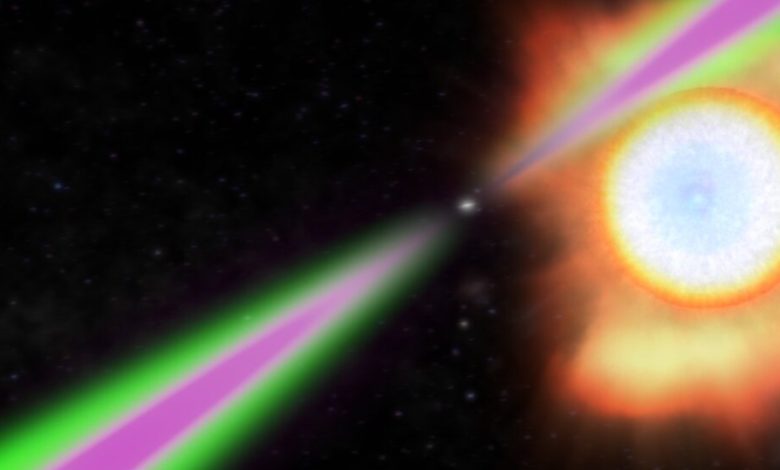The Weirdos of the Star-Spangled Cosmos and What They Reveal

THINGS THAT GO BUMP IN THE UNIVERSE: How Astronomers Decode Cosmic Chaos, by C. Renée James
There is one particular pulsar, a type of quick-spinning dead star, that holds the current record for the fastest rotation of any celestial body in the known universe — 716 times per second. By contrast, the blade of a Vitamix can turn around 333 times every second, but a blender is small enough to sit on a countertop, and a pulsar is a city-size ball of neutrons that floats in space and contains the mass of half a million Earths.
“One can read numbers like this and think, ‘Oh, that’s interesting,’” writes the astronomer C. Renée James in her new book, “Things That Go Bump in the Universe.” One can also feel that “grasping the reality is impossible.” But, she says, “You should still try.”
Pulsars may seem unfathomable, but they are worth studying both for their own sake — they are among the weirdest things in the cosmos — and for the insight they can offer. They can help us measure the distance between suns and advance our knowledge of nuclear physics. A pulsar like the record-setting PSR J1748-2446ad, which James usefully renames Zippy, is a key tool in the relatively new field of transient astronomy: the study of fast, short-lived, violent phenomena in what we otherwise perceive as a mostly empty and unblinking universe.
The James Webb Space Telescope and its siblings have revealed fascinating portraits of a cosmos spangled with stars, clouds of dust, filaments of gas and the whirling arms of galaxies. “Things That Go Bump in the Universe” introduces several of the most unusual cosmic characters in these realms, including the extremely abundant and ghostly particles known as neutrinos, which seemingly interact with nothing after they are born, whether they arise in horrifically violent stellar death throes or in the natural decay of the potassium in bananas. We also meet “black widow” pulsars (over eons they consume their binary-star companions) and see black holes merge. One such collision 1.2 billion years ago made space-time around the Earth shudder in 2015.
Gravitational wave astronomy has ushered in an entirely new paradigm of astrophysics. Researchers can now probe theories of how the universe expanded after the Big Bang, tracking the vibrations like a piano tuner listening for the sound coming off her vibrating fork as she presses a key. By combining sonic data from across the universe — merging black holes tend to strike a note in the bass clef, Zippy sings 1.5 octaves above middle C — with older methods of observing all the light we can and cannot see along the electromagnetic spectrum, astronomers can sketch a history of the cosmos.
James’s journey through the study of these objects is exhilarating, sometimes difficult, but ultimately rewarding thanks to her cheerful, agreeable prose; she is better than most astrophysicists at explaining their sometimes abstruse work. The sun is “a mediocre star.” The detectable changes in air pressure after the 1883 Krakatoa volcano eruption, used by James to introduce a scale of stellar explosions, “whispered secrets about their cataclysmic origins.” The storied Parkes Radio Telescope in Australia, now called Murriyang, “single-dishedly discovered” about half of known pulsars.
She also employs metaphors and analogies, sometimes excessively; the space between certain binary stars is a “doorway” for “kissing cousins” whose activity is “nothing like filling a bucket with a garden hose.”

Still, metaphors and analogies, along with vignettes from the author’s travels to meet a rotating cast of scientific guides in the field, help keep the lay reader grounded. In one chapter, James accompanies Duane Hamacher, a cultural astronomer at the University of Melbourne, for a walk across the Hornsby Plateau in search of ancient rock carvings, including the Emu of the Sky, an aboriginal constellation “sculpted out of the dark dust lanes of the Milky Way galaxy” whose head overlays the Coalsack Nebula.
“Things That Go Bump in the Universe” is strongest when James relates cosmic events to her own life, or at least our own conceptions of time. She was a graduate student during one of the most important observable collapsing stars. On Feb. 23, 1987 — “minus 168,000 or so years for light travel time” — the star known as Sanduleak -69° 202 finished forging the last atoms of silicon in its heart into iron. “In a flash, a volume the size of the moon shrinks to the size of a city,” James writes. The star’s outer core rushed inward to fill this vacuum, smushing electrons into protons and forming fountains of neutrinos. The nearly massless neutrinos were so numerous and thickly packed that they eventually tore apart the star’s shrinking core and surged outward in a tsunami of energy. Much later, a quadrillion of them arrived on Earth, spraying “every single person alive” without harm.
Readers who may not have kept up with the frenetic pace of astrophysical discoveries in the past 10 years will enjoy James’s descriptions of how astronomers know what they know, and how they know what they still need to find out. Like a pulsar, the book is at times dense, but it also dazzles. It recasts modern astronomy as the search for transient, explosive events, and the messages they contain if only we can decode them.
This stands in stark contrast to the way many of us regard the stars. We like contemplating them for precisely the opposite reason; during the vast majority of human history, we have only seen them as placid pinpricks in an ocean of nothingness. But I find it comforting to know that the lives and deaths of stars, so to speak, are as dynamic, as tumultuous and as inscrutable as our own.
THINGS THAT GO BUMP IN THE UNIVERSE: How Astronomers Decode Cosmic Chaos | By C. Renée James | Johns Hopkins University Press | 289 pp. | $29.95



